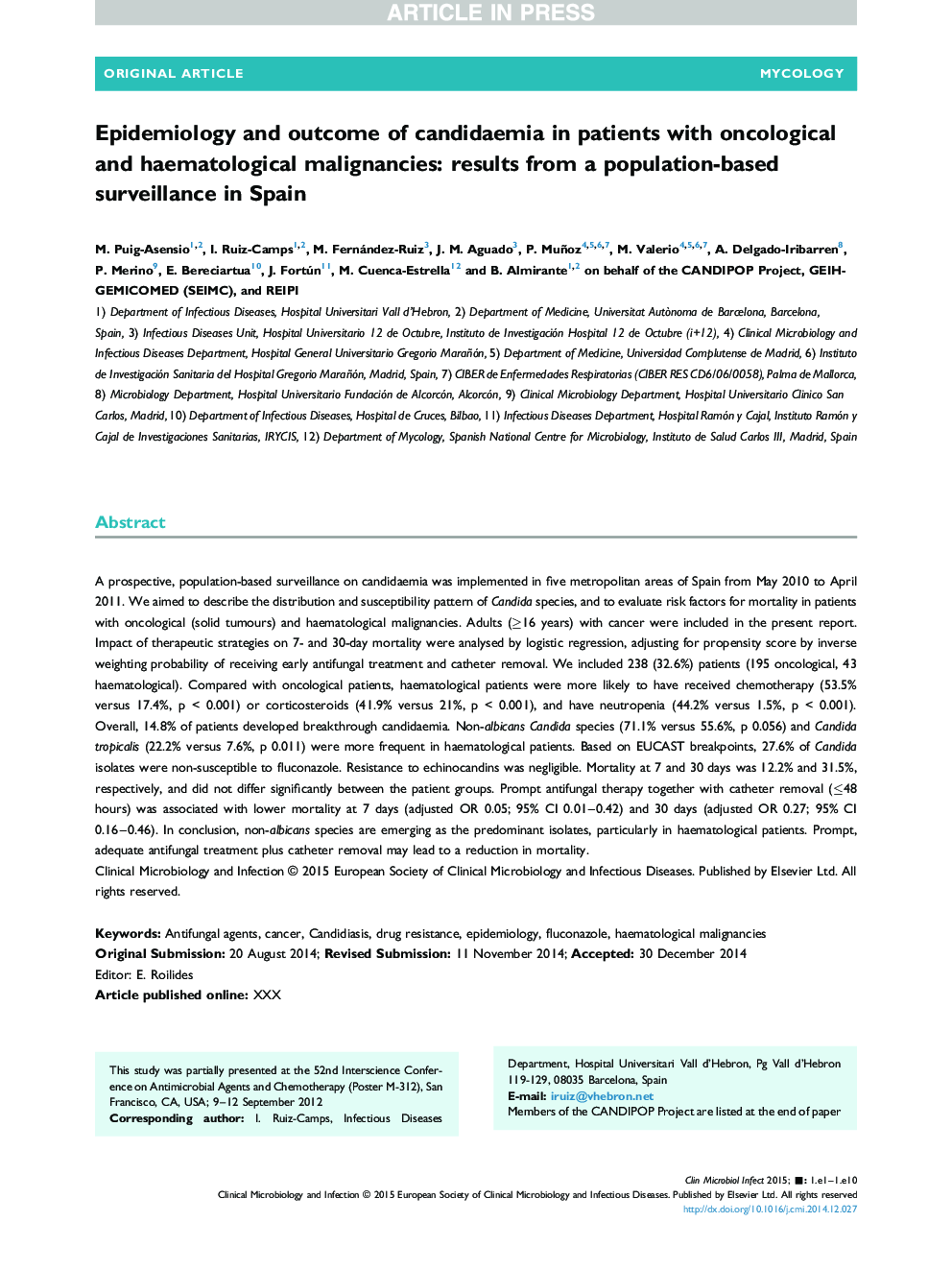| کد مقاله | کد نشریه | سال انتشار | مقاله انگلیسی | نسخه تمام متن |
|---|---|---|---|---|
| 6129675 | 1222162 | 2015 | 10 صفحه PDF | دانلود رایگان |
عنوان انگلیسی مقاله ISI
Epidemiology and outcome of candidaemia in patients with oncological and haematological malignancies: results from a population-based surveillance in Spain
ترجمه فارسی عنوان
اپیدمیولوژی و نتیجه کاندیدایی در بیماران مبتلا به بدخیم های انکولوژیک و هماتولوژیک: نتایج حاصل از نظارت جمعیتی در اسپانیا
دانلود مقاله + سفارش ترجمه
دانلود مقاله ISI انگلیسی
رایگان برای ایرانیان
کلمات کلیدی
عوامل ضد قارچ، سرطان، کاندیدیازیس، مقاومت دارویی، همهگیرشناسی، فلوکونازول، بدخیمی های هماتولوژیک،
موضوعات مرتبط
علوم زیستی و بیوفناوری
ایمنی شناسی و میکروب شناسی
میکروب شناسی
چکیده انگلیسی
A prospective, population-based surveillance on candidaemia was implemented in five metropolitan areas of Spain from May 2010 to April 2011. We aimed to describe the distribution and susceptibility pattern of Candida species, and to evaluate risk factors for mortality in patients with oncological (solid tumours) and haematological malignancies. Adults (â¥16 years) with cancer were included in the present report. Impact of therapeutic strategies on 7- and 30-day mortality were analysed by logistic regression, adjusting for propensity score by inverse weighting probability of receiving early antifungal treatment and catheter removal. We included 238 (32.6%) patients (195 oncological, 43 haematological). Compared with oncological patients, haematological patients were more likely to have received chemotherapy (53.5% versus 17.4%, p < 0.001) or corticosteroids (41.9% versus 21%, p < 0.001), and have neutropenia (44.2% versus 1.5%, p < 0.001). Overall, 14.8% of patients developed breakthrough candidaemia. Non-albicans Candida species (71.1% versus 55.6%, p 0.056) and Candida tropicalis (22.2% versus 7.6%, p 0.011) were more frequent in haematological patients. Based on EUCAST breakpoints, 27.6% of Candida isolates were non-susceptible to fluconazole. Resistance to echinocandins was negligible. Mortality at 7 and 30 days was 12.2% and 31.5%, respectively, and did not differ significantly between the patient groups. Prompt antifungal therapy together with catheter removal (â¤48 hours) was associated with lower mortality at 7 days (adjusted OR 0.05; 95% CI 0.01-0.42) and 30 days (adjusted OR 0.27; 95% CI 0.16-0.46). In conclusion, non-albicans species are emerging as the predominant isolates, particularly in haematological patients. Prompt, adequate antifungal treatment plus catheter removal may lead to a reduction in mortality.
ناشر
Database: Elsevier - ScienceDirect (ساینس دایرکت)
Journal: Clinical Microbiology and Infection - Volume 21, Issue 5, May 2015, Pages 491.e1-491.e10
Journal: Clinical Microbiology and Infection - Volume 21, Issue 5, May 2015, Pages 491.e1-491.e10
نویسندگان
M. Puig-Asensio, I. Ruiz-Camps, M. Fernández-Ruiz, J.M. Aguado, P. Muñoz, M. Valerio, A. Delgado-Iribarren, P. Merino, E. Bereciartua, J. Fortún, M. Cuenca-Estrella, B. Almirante, the CANDIPOP Project, GEIH-GEMICOMED (SEIMC),
